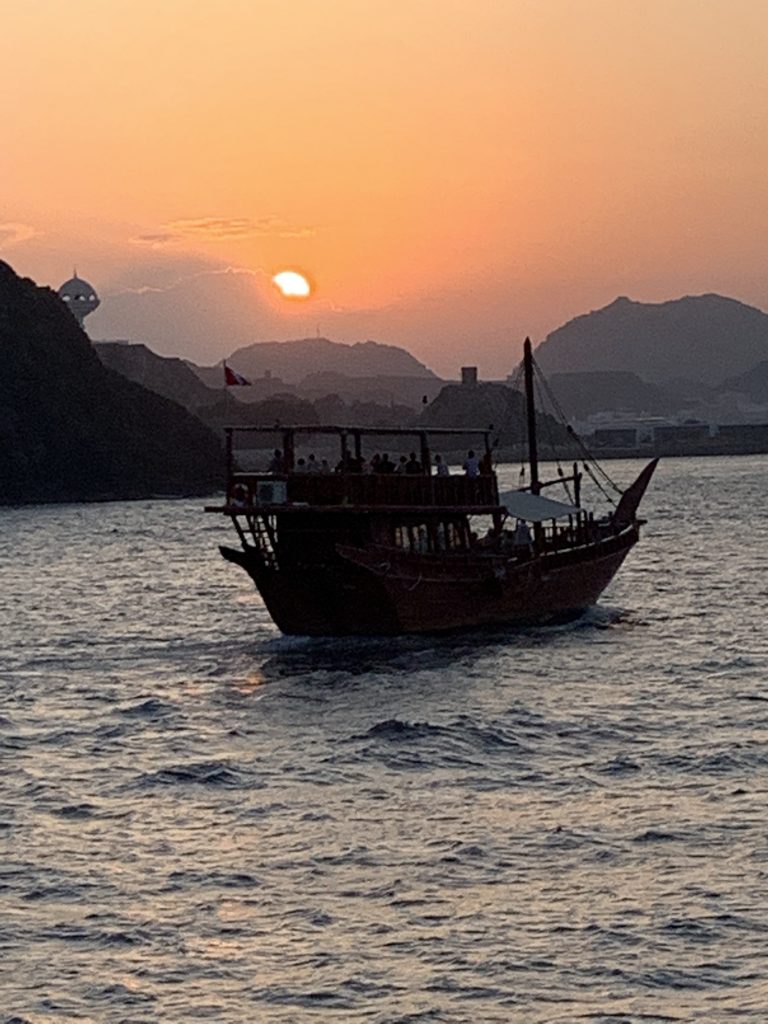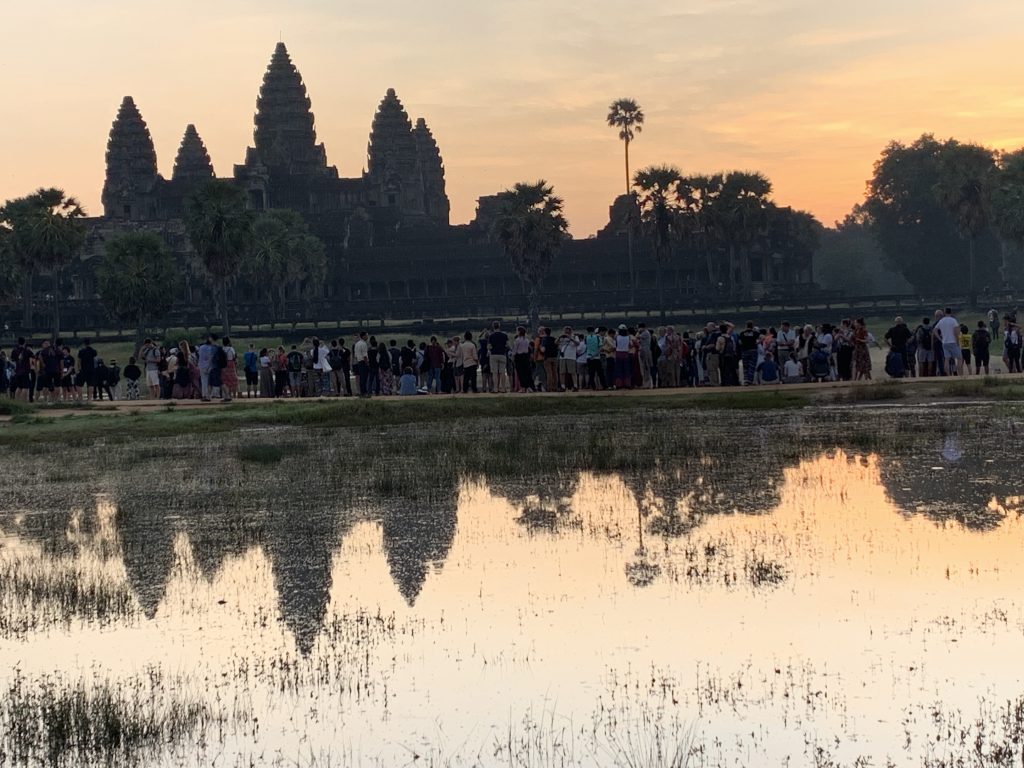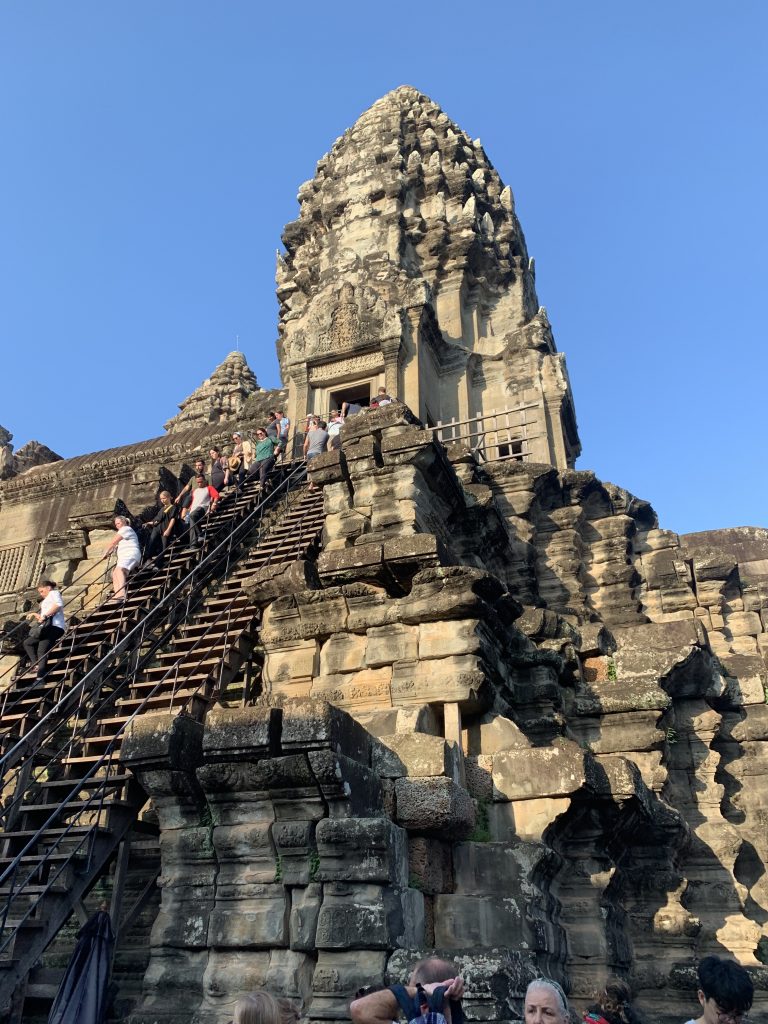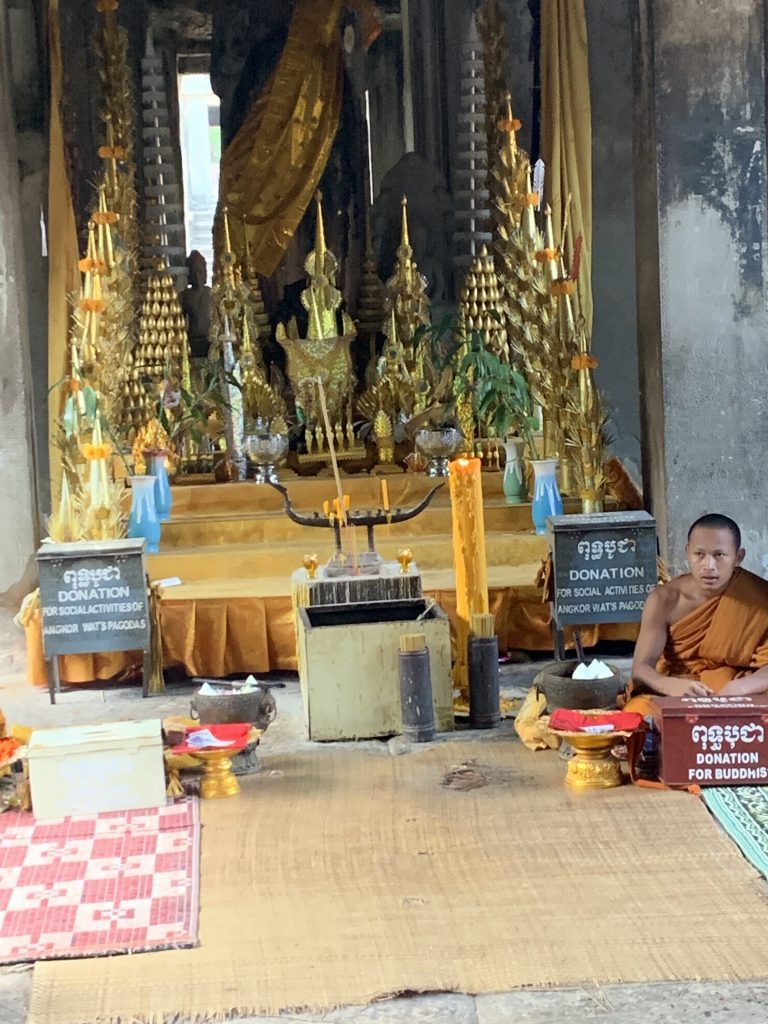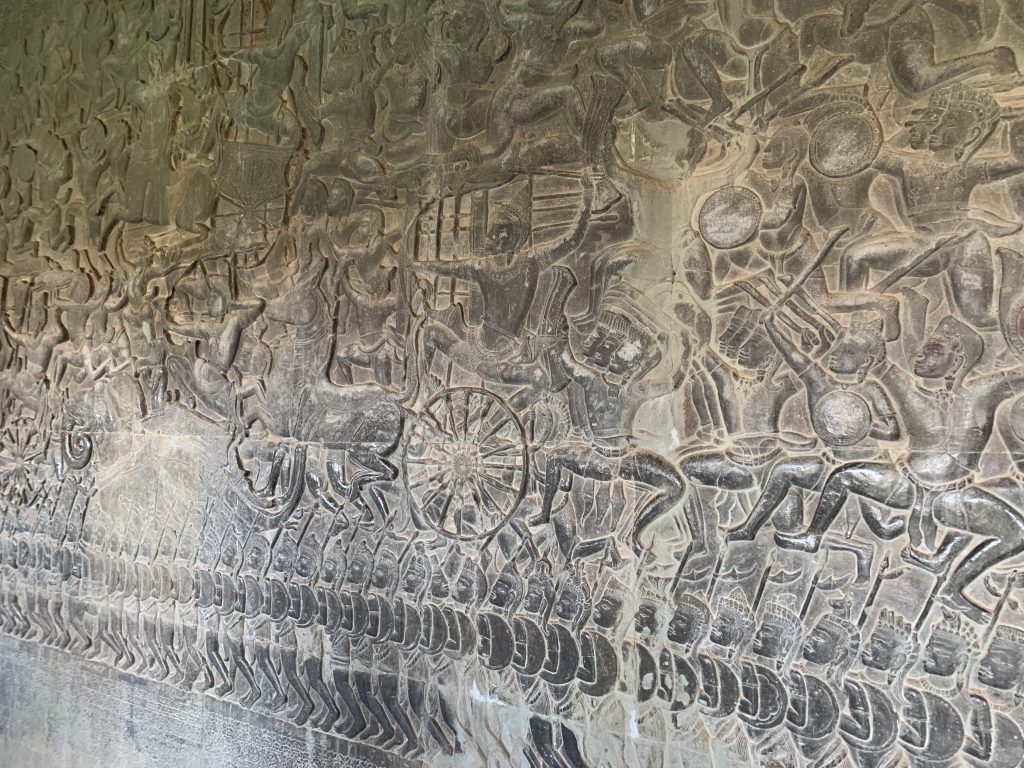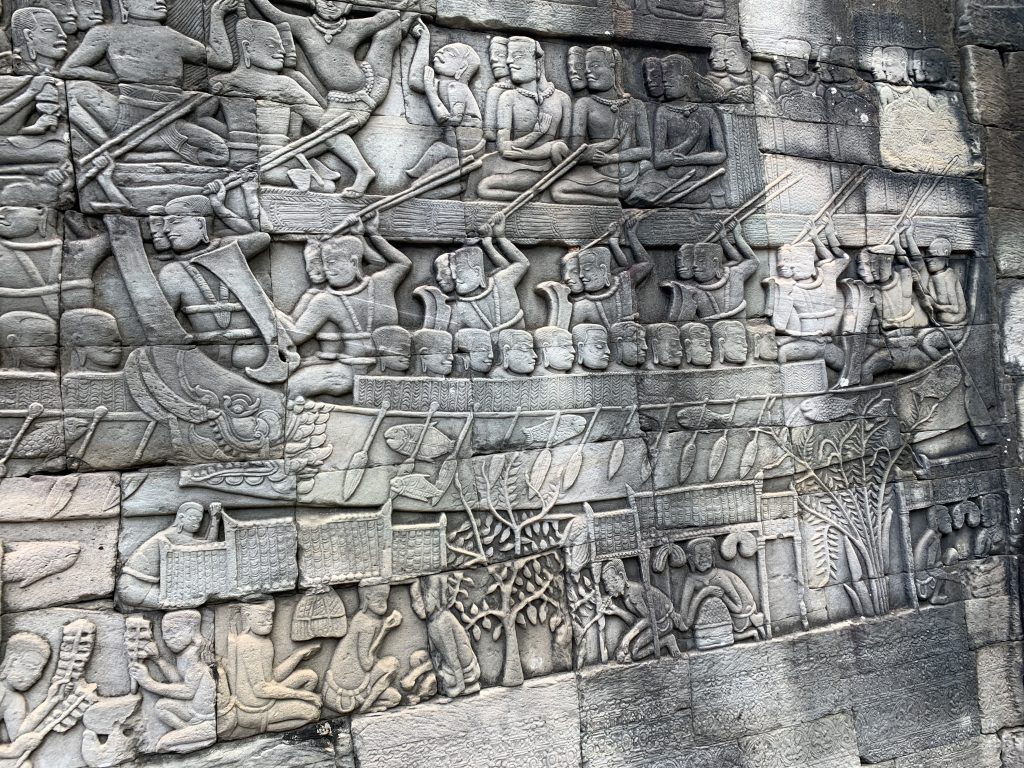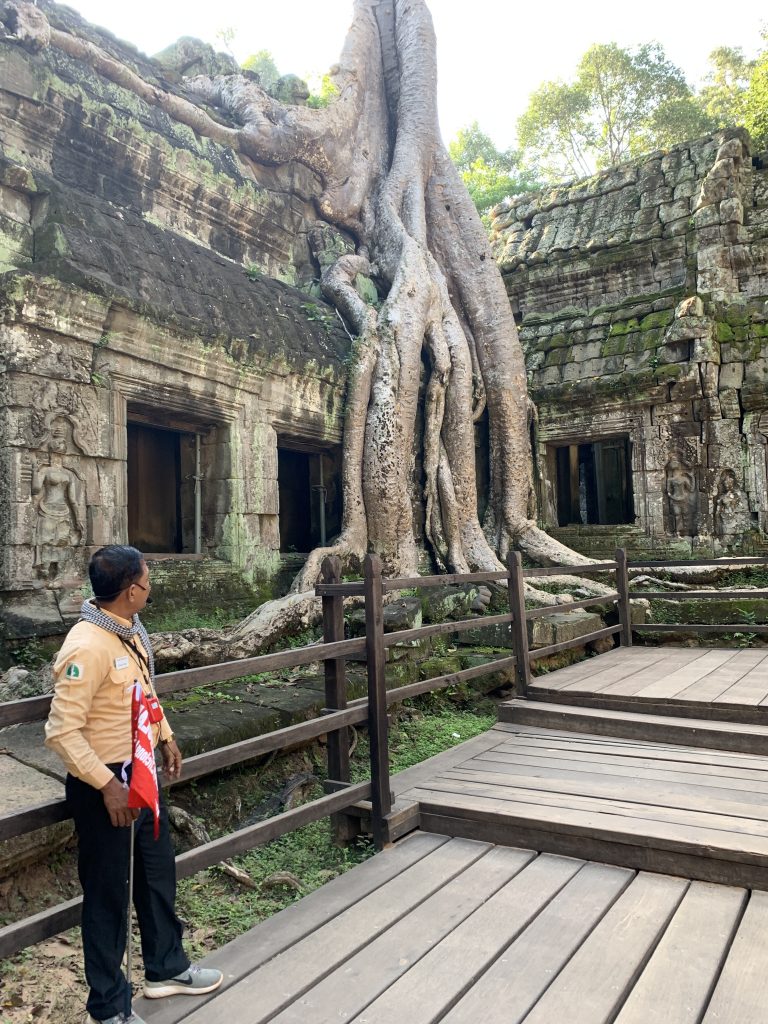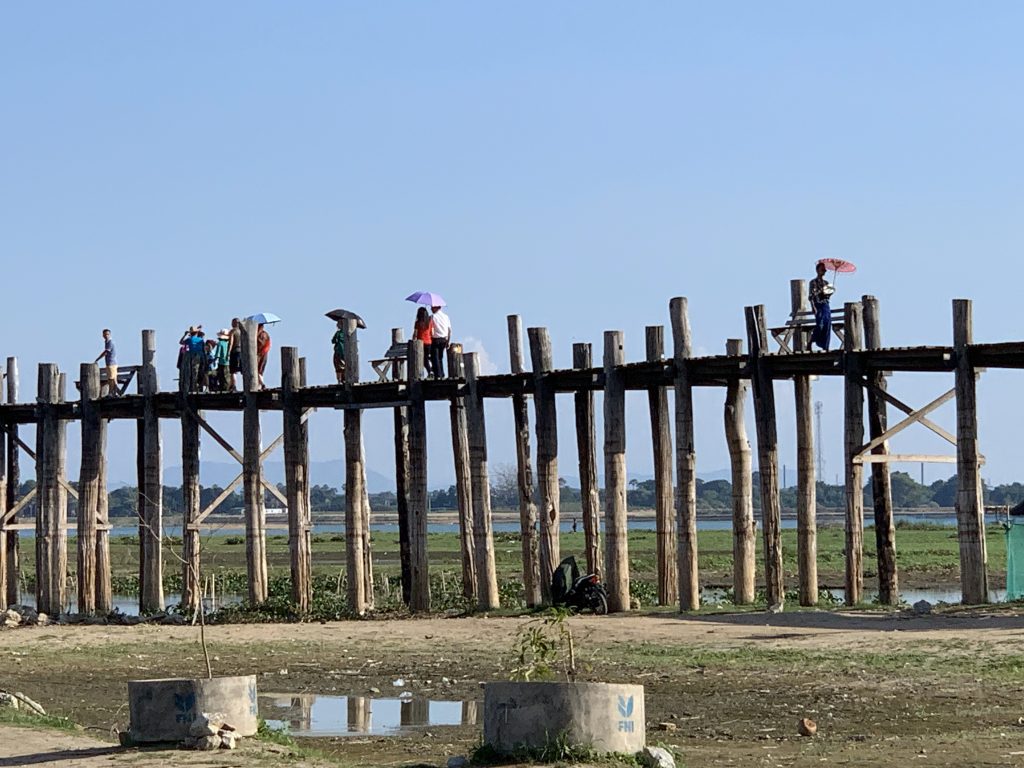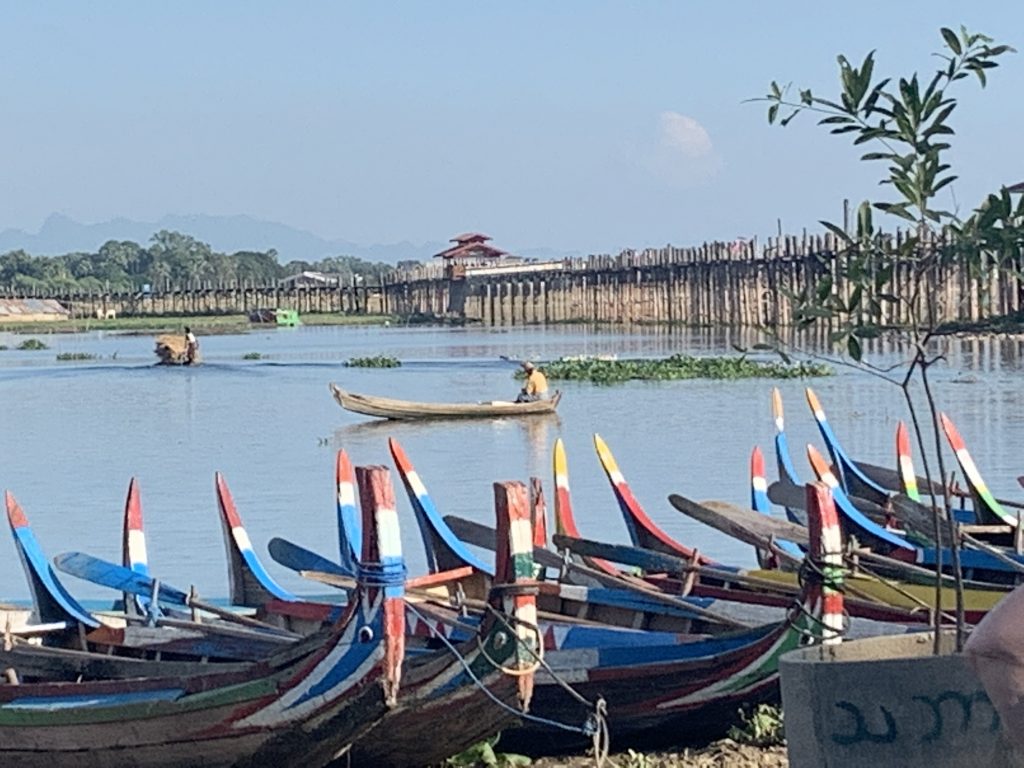Road Scholar an outfit introduced to me by an American friend are a non-profit organisation, into educational stuff, so not a bucket and spade brigade, and the trip looked interesting. A whole bucket of bucket list stuff, knocked off in one fell swoop. Eat your heart out Greta! 48 folk with a few hangers on, i.e. folk to make sure we are all herded in the right direction at the right time, from London to China and back; stopping off in Cairo, for the Pyramids and the museum, Jordan for the Wadi Rum and Petra, etc etc. OK and Delhi for Taj Mahal, China, the wall & forbidden city, a quick internal flight on a local airline to see the Xian warriors. Hopping back via Cambodia Burma and Oman.
The trip started in the UK to see Stonehenge, and Avebury, a fish and chip lunch (trad English for the US contingent), dear God how awful was that. But then this isn’t a culinary trip. And the US contingent is everybody but me. I’d considered dipping out of this bit and meeting at Stansted but thought that I ought to pitch up and make friends.
Our leader is a lovely lady Annette (British) and, says it’s good to have some British humour, aboard, i.e. me. The crew on the plane are great, plenty of them to look after us, the Chef Darren is conjuring up good stuff, and there is an engineer to check the oil levels too.
Mick Jagger and his entourage have rented this plane before, as have Guns N’ Roses so if it’s good enough for them.
After a back-door entry to Stansted, (there is one very funny lady Marla here an expert on Easter Island, who specialises in butt jokes), into a lovely lounge, our plane awaited and we all had our photos taken, next stop Cairo!
Cairo
Cairo is a dusty sprawling city of 22 Million, a fifth of the population live there. We arrived on Friday, their weekend so traffic was “light”. The place is a sprawl and a building site, much isn’t finished and isn’t going to be any time soon as tax is paid when it is. Apartment block after block of unfinished partly built, partially inhabited buildings abound. Some buildings have floors that have collapsed and people living in other parts of the same building. A “new Cairo” is being built and so is a “new Luxor” to contend with the burgeoning population. A new baby turns up here every 37 seconds. This is not a rich place, and a lot of people are working hard to make a living.
First stop is the Pyramids, the Sphinx and then the Solar boat museum.


Papyrus part of 35 M 



There is a new museum coming, right next door to the pyramids and the old museum, will be refurbished. The museum hasn’t changed in decades. Artefacts were put in wooden and glass boxes in the 1920’s, or whenever and the information on closely typed cards which are now greying and bending. Some of the items are already in plastic wrap ready to move to their new home. What is not in doubt is the magnificence of the collection and hopefully the new museum will do the artefacts justice. Better lighting and air conditioning to make it all easier to see and understand will help.
The King Tut stuff (plus the other pharaoh stuff), is fabulously amazing and the intricacy of its manufacture one feels wouldn’t be a walk in the park today. That is such an understatement, the workmanship and designs are unbelievable for the period, time and tools available. King Tut died 1325BC and the mask, is but a “bagatelle” in the 5000 or so items found in his tomb as one of the “unimportant” Pharaohs. The amount of extraordinary stuff that must be sitting around stolen from the tombs of the really important guys must be staggering. Or maybe just melted down ….
There is a papyrus in the Museum that reminded me of the Bayeux tapestry. It is 35 Metres long but in pristine condition, telling a 35M long story but still vibrant in colour as if it had just been written and painted yesterday.
Aqaba

Aqaba with lovely new marina 


Petroglyphs, camels this way .. 
Anyone for tea!
A short hop and we land in Aqaba a port on the Jordanian coast, or the Hashemite Kingdom of Jordan to be more precise. Desert, 10 Million people mostly Muslim, including 2M refugees from Iraq and Syria. They are clearly hospitable people.
We drive to the Wadi Rum, (wadi means a valley), in the desert, inhabited by Bedouin people who happily drive us around the desert to see the Petroglyphs (rock carvings of camels), give us tea and hope we will buy their wares. A lecture the following morning explains how the Bedouin, one of the Arab tribes that live here, cook, make their tents from material spun from the wool of their goats as well as their clothes which the women embroider. They make their cooking utensils, coffee pots too. Essentially if you have a camel some sheep or goats you are pretty much good to go. That said we didn’t meet any folk living quite so simply. Four wives are allowed but doesn’t seem to happen. Multiple children are one thing, multiple wives evidently quite another. Arranged marriages are the norm and it is incumbent on the groom to pay for absolutely everything. A house, a wedding, and a party which can be up to a thousand people!
Petra the following day exceeds all expectations. Our guide has got us to the right places at the right time for the light, to get the best pictures (an early start was worth it), and importantly we are first at the buffet lunch. As we leave there is a queue forming for a wonderful array of dishes, which feels like a bit of a mission to achieve, in such an environment. Though there is a back door to the valley, for the two restaurants to get the provisions in and out, it is just the visitors who must do the trekking. The locals who used to live in the caves and temples in the area surrounding have now been re-housed, and spend their days selling local wares to the tourists. Sadly, there are some children around who should be in school.
The clues (on the government printed map) suggest a 5-mile round trip into the pink city of Petra and back. My phone tells me I have walked over 4 miles by lunch and I am not walking back in the heat. I contract a deal with one of the young lads to ferry me back to the treasury on a four by four donkey, he tells me to relax whilst aloft. Relaxing is something one does in front of the telly, not miles in the air on a donkey. I manage to hang on but feel sorry for the donkey and so tip my guy and he actually looks pleased.
There is a lovely small but informative museum at the entrance to Petra and it would have been useful to visit first. That would have delayed our entrance and then missed the light. (Perhaps the evening before). A visit in the early morning is a must to get the best light.
Next stop Delhi, where I suspect we will be in smog, traffic and throngs of people.
Delhi 17/10/2019

Taj Mahal 
Agra Fort 



Neat job on the wiring front!
After a brief visit to the Jama Masjid (Mosque all open air so not a lot to see,) a rickshaw ride through Chandigarh Chowk to see the wedding market, was the highlight of the day. If you are getting married in Delhi you may come here for all the beads and saris and general paraphernalia that a wedding requires. These are serious events, presents like saris, gold bracelets and necklaces need to be bought for all the family, before any thought goes to the feeding of them. Typically, weddings can last over say 4 days. You start saving early. Our guide (who is unusually divorced) is not surprisingly encouraging her son to elope!
In the market the wiring is precarious but seems to work and amazingly meters charge people for their electricity. Monkeys abound and it is good karma to feed them. Bars on houses are not to keep the burglars out, but to keep the monkeys out, they are so smart they will go straight for the fridge!
For balance we went to see what the Sikhs get up to in the Gurudwara Bangladesh Sikh temple, the largest in Delhi, feeds 5000 or so people a day, part of this religion is service to others. So, plenty of folk give up their time to provide two meals a day, you can just turn up, any religion, rich or poor. The only criteria are, you must just wash your hands, have nothing on your feet, and wear a scarf, or something on your head. And you will get fed. Maybe even with some of the bread I made. So, with no social security you can get fed twice a day here!
The Oberoi is where to stay. Staff are fabulous everything works, nothing is too much trouble. The first morning one young man Tammy the restaurant manager asked me “ Can I assume you’re enjoying your breakfast” I said “you can if you want”. At which point he crouched down and asked me what was the problem. I told him I thought his scrambled eggs had been done in a microwave. This causes some consternation the chef was summoned and I was assured this wasn’t the case. Later at dinner the waiter asked me if I’d like some wine. I asked him where it was from. He said Spain, So I asked him what it was. He told me Goats do Roam. I said well that comes from South Africa from the Fairview Estate and they do have goats and I have been there, so yes please. His colleagues were tittering behind his back as this was going one. Anyway, from then on, my breakfast is supervised by Tammy and my wine glass is always full. Laundry is done to perfection wrapped up as beautifully as anything Harrods can manage and then returned in a wicker basket. I have a butler and task her with polishing my shoes.
There does seem to be a push in India to reduce waste and plastic. Single use stuff is banned. Shopping bags are degradable fabric. The street food used to be served in leaves or on unfired pottery cups which could then be discarded with impunity; they now have small foil containers and plastic cups for chai. Not everywhere and often a mixture, but unfortunately, a retrograde step.
Jaipur
China is cancelled. I am offered a derisory amount in recompense (which I reject and will do battle later) and am then wafted off to Jaipur 150 miles down the road.
Jaipur is in Rajasthan. Desert, camels, the Palace of the Winds (Hawa Mahal) built in 1799 with open windows to let the breeze blow through in the summer months and of course the Most Exotic Marigold Hotel!
Jaipur aka the pink city, a royal city established in 1727, population 5M ish and the capital of Rajasthan with a 21-year-old Maharajah.
Continuing the royal theme, the city Palace with its colourful striped flag can be visited and this clearly is a splendid place, silver pots for storing water the largest in the world, guarded of course and indeed there are guards all around the palace in various uniforms. The Maharajah is now opening his house (or the City Palace as it is normally called, and you can go stay via Air BnB.)
The C16 Amber (pronounced Amer) Fort on the outskirts of Jaipur, a home of Maharajahs past, has been neglected over the century’s but in its day must have been spectacular and the best preserved part, is the Hall of Mirrors.





Poppadom anyone?
Not having seen a Hindu temple so far, we arrive just in time for a service at the new all white marble Birla temple. A completely new experience for me, folk enter the main hall, then curtains are drawn to reveal statues of Vishnu (The Preserver) and his consort Lakshmi, both carved out of one piece of marble. As they are both elegantly clothed and bedecked with jewellery, flowers & wild make-up, I’m not sure spending money on the marble was worthwhile, as its not now obvious. The service fortunately of a short duration (which as there are no seats and my attention span is short), seems to consist of the priest in robes wafting incense around with a cacophony of extra loud music. Everyone then files past the priest and waft the incense over themselves, wander round the back of the two deities and receive a little holy water and then make a donation. Nonetheless it’s a beautiful temple and has a dome for the Muslims a pyramid for the Buddhists and the traditional Hindu spire or Shikhara.
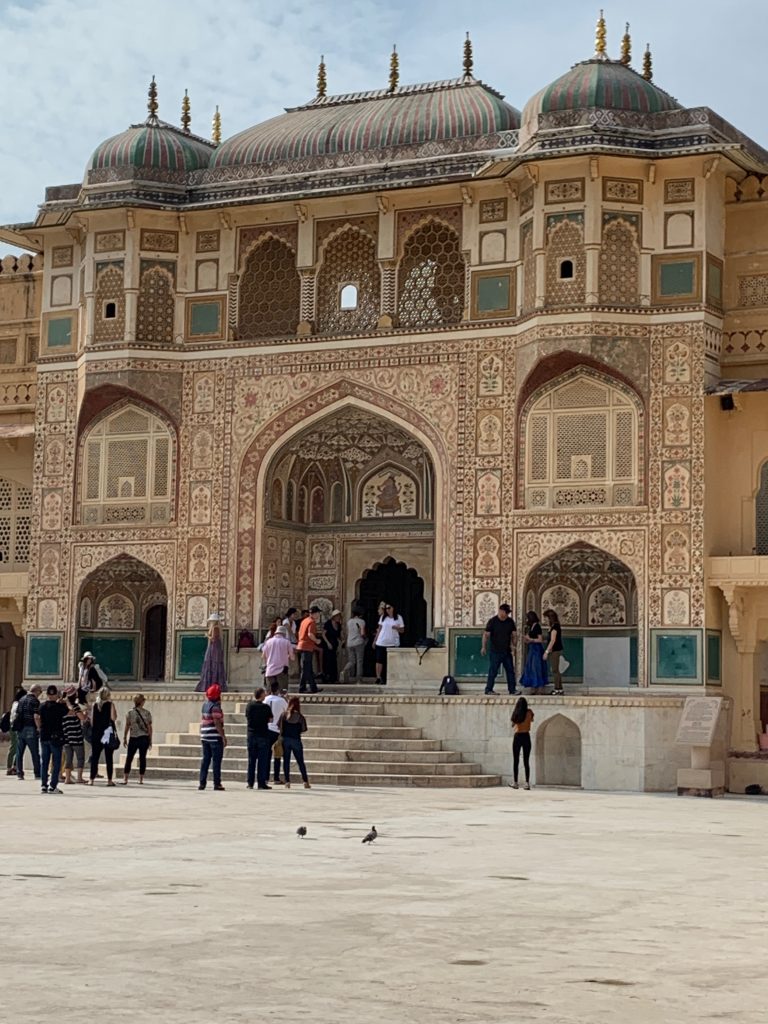
Amber Fort 
Birla Temple
Fairmont hotel one of the few places that had 50 rooms at short notice in Jaipur and evidently, they had to conjure up some extra staff to deal with us and it shows. That said the welcome as we return is noisy and enthusiastic. Two drummers with huge kettle drums at the outer door. Petals strewn over us from a height as we enter the hotel, and a sitar and drummer playing as we finally enter the hotel after security has looked at all our bags. The evening finds a bangle making chap complete with portable charcoal fire sitting in the bar along with an astrologer, dancers and singers. I get him to make me a bracelet. Many take advantage of the astrologer and come away very satisfied! I imagine all will live long happy lives and find new husbands. Of 48 there can only be a handful of men and with 2 exceptions married, one will never ever be married as he hasn’t cut his toe nails this century and the other an extreme live-wire, which will take some keeping up with.
The maintenance department is working hard, I nearly suggest my maintenance man moves in as he is visiting twice daily, the shower doesn’t switch off, the lights disappear as in a power cut, he tells me I haven’t put my card in the slot properly, righty ho off you go then; he fixes the point where the card fits. The toilet seat “can you glue it back to the toilet before I return”. Nothing happens and I call to ask them etc fix and the very nice lady enquires “you want your toilet seat in your room”, erm no I don’t, just attached to the toilet, a new one is conjured up just slightly less wonky than the last.
The room is damp, the place is old and traditional, the food is fine but the fabric of it needs updating really. I have a massage and a facial and because I don’t know the back way, I find myself walking through the hotel in a dressing gown. The clothes I’ve had made have arrived as has a new ring now made a little larger and I’m invited to sit to try it on. I think not, the robe is only just doing its job, sitting would be embarrassing. Staff are willing but ineffective. The Oberoi Delhi staff were not only willing & effective but absolutely fabulous.
With 4 days to kill before the next leg of the trip in Cambodia we find ourselves visiting a couple of factories one making blue pottery and another making paper out of discarded fabric. Fancy paper bags for Walmart amongst other stuff. We also have lunch at the Rambagh Palace Hotel. 30 years ago, when I was in India last, I had lunch here too, so I explore a little to see if there are any changes. The staff fall over themselves when I say I was here so long ago and make me very welcome. It is sumptuous and splendid and I’m sorry to return to my damp room in Jaipur. Whatever splendours Jaipur can conjure up. It is still India, cows roam the streets, pigs too in Jaipur, which weren’t obvious in Delhi. The poverty and disabilities of the beggars are profoundly depressing, the dirt and rubbish everywhere is of epic proportions. The government evidently is trying to change things and towns get prizes for being clean and tidy. There is clearly a mindset problem and will take some time to change. It isn’t obviously different from when I was here 30 years ago.
Cambodia
Cambodia it seems has never been free. Currently North Vietnam seems to be in charge, and talking disparagingly about the incumbent regime can land you in jail.
Jaipur to Siem Reap for Angkor Wat and assorted temples, if we had a week there are 1,080 newly discovered temples in the area. Siem Reap means the defeat of Thailand thus named after a war with Thailand in the distant past.
Our guide who was a small boy during the Khmer Rouge days lost his father who was worked and starved to death, an uncle and 3 cousins. He says everyone lost someone and it is clear why; of a population then of 7M, 3M were killed. Anyone educated or a bit whiter than others or who wore spectacles, were killed. When all of Hanoi was emptied then looted, he was displaced with his mother. Sometime later he was allowed to return to find his house was occupied by the Khmer Rouge and prisoners were kept there and routinely tortured. Which as an 8-year-old he witnessed daily. One of our people the aforementioned Marla (a very nice lady from Wyoming who spends some of her time awarding scholarships to Easter Islanders who will then go back and help their community), asked him further about his family and he said he had three children, and had lost his wife to breast cancer; which is something that is untreatable it seems here, as are all cancers. When you are in a hole Marla stop digging!
As a result of the genocide special skills were lost. Cambodia used to be famous for its lacquerware and it took two French brothers to come to Siem Reap to teach the locals how to do it. The results are fabulous. Go visit and buy.
We were here to see temples and the Sofitel is a good jumping off point, French, so the food is good, and they know how to run things.
A 4 am start finds us at the Angkor Wat ticket office as they open at 5 am. A $60 ticket buys you as much access you need over as many days as you need. US Dollars here work very well, as 4,000 Riels is worth 25 cents. The sunrise is what we are here for and with a lake in front of the temple the reflection is haunting. The whole temple was a small city 5.5 Miles square and surrounded by a moat 200 Meters wide full of crocodiles. The main causeway is under renovation so we crossed the moat on a wobbly floating bridge. Bit like walking down a pontoon to find one’s boat except somewhat larger.
The temple is dedicated to Vishnu. Vishnu gave birth to Brahma through his navel and Brahma created the world. Seems reasonable enough. The walls are covered in drawings depicting the king, battles of soldiers, Cambodians v the Thais, horses, chariots and spears. Apella or heavenly dancers abound, many with shiny boobs where people (boys will be boys), have rubbed the stone to a high polish. Now fortunately roped off just out of arm’s length.
Angkor Thom follows. This was a city and the last capital of the Khmer Empire to the mid C15, 3k squared, housing 80 thousand people the stone reliefs here depict scenes from life, cooking, food on a barbecue, eating, giving birth (that one’s a bit difficult to fathom).
As kings came and went so did their religions, so if a Buddhist King died and the next one was Hindu then the Buddhist trappings were removed, so there are areas of wall that are essentially just defaced and erased. Hindu trappings would then be installed and this alternated over several generations.
The temperature in the 90’s but with humidity at 94% it felt in the hundreds and now thus drenched with sweat I was templed out and so chilled by the pool, with my new best friend from Wyoming and with a bicycle riding pool boy fetching and carrying cocktails and anything else required.
Mali’s will find you a good lunch/dinner in Siem Reap.
A quick visit to the tomb raider temple where Angelina Jolie filmed was essential before our flight to Mandalay, Ta Prohm the “jungle temple” so called as trees are growing out of the buildings. And they have had over 300 years without interruption to do so. 2000 Monks lived here with 600 dancers back in the day, which sounds quite fun if you are a monk. India is helping to restore some of the buildings which struck me as odd, as the last effort India helped with was at Angkor Wat and they used acid to clean the temple and it has turned black! But then what do I know.
Burma or Myanmar as it used to be called before the British came along.
Mandalay Burma’s 2nd city, our first port of call, with a population of 1.2M, is rapidly being taken over by the Chinese, who marry Burmese women and demonstrate their wealth by surrounding their houses with razor wire! I asked our guide if there was much burglary in Burma and he said “none”. I can attest to this as I never managed to master how to lock my room during the 2 nights I was in Burma and I have to say it was a busy as any knocking shop. There was a procession of workmen, coming to fix the air conditioning, replace an electric point that didn’t work, bring me a tonic water without a glass or ice, return with glass and ice, drop on floor, return with the cleaning up guy and then with a new glass and ice, all while I am wondering if I can get out of my dressing gown before the next guy arrived, and perhaps go to dinner. I leave eventually to come back to find the air con working!
Armed with the equivalent of “good morning” and “thank you” so feeling fluent in Burmese, we set out on our first stop to see a silk factory, making the best silk money can buy evidently, and if you’re getting married you want some of this silk. It is back-breaking work in the heat of the day, over 95F in an airless factory breaking all sensible elf and safety rules, and there are no fans. Not many workers either, they have gone home as too hot, only to come back later and finish their day in the evening. Often working in pairs with the finished pattern on the reverse, it is intricate work.
Many folk have yellow painted faces and this is called Thanaka and it is a sun block made from the sap of a tree.
The men are wearing what look like sarongs, but are called Longyi and worn by all men and women from teenage years. Boys wear shorts till then, a hangover from the British Raj days. Like kilts the men wear nothing underneath, mostly. Longyi is a tube of material, which you step into and then men tie in a knot (and with some dexterity) can turn into shorts, sort off, if they are fishing or in the fields, or walking through mud etc. Women do much the same but wrap around, and make neater. You need to turn these three times a day so you don’t wear out the seat of your Longyi. They cost about $5 and men have about 10 of them. Nuns only 3 and they are pink, monks the same and they are maroon. The dress is elegance personified. They all look like Aung San Suu Kyi. Us lot look scruffy by comparison.
It is a short hop to Bagan from Mandalay; out hotel overlooks the Irrawaddy with boats lazily wandering up and down.
Bagan, became a UNESCO site on 6 July 2019, this means that our hotel and others in the area, must close by 2020. The local people had houses here till 1992, and indeed our guide lived here until then, in among the 2,200 temples in 19 square miles. Everyone was resettled, but they didn’t go quietly, the water and electricity had to be cut off before folk would leave.
Bagan has about 11 days of rain, and 8 inches of rain a year, so crops are sesame seeds, peanuts and cotton. No rice.
This isn’t really a culinary destination. Siem Reap was better for food (the French influence helpful I’m guessing), here in Bagan it is much cheaper and more cheerful. Alcohol is a problem; Beer comes in huge bottles; local rum is cheaper than beer and much of the adult male population are drunks evidently. So not much different from England then!
The history of Bagan is interesting, it was a prosperous trading place, with a navigable river. In the late 11C Marco Polo came here. It was a golden age, Kings taxed the citizens and built big temples, and people built their own small personal stupors and temples for private worship. As they all now believed in reincarnation they were investing in the future. In 1059 Buddhism superseded animism so sacrifices ceased, and loving kindness took over!
Evidently news spread of this prosperity, and Kublai Khan feeling insecure came down from the north and trashed the place, horses were no match for the nice Buddhists, but they soon found the heat too much and went back home leaving a mess behind.
Pagodas can be a temple or a stupor, stupors are inverted and conical with no entrance, and temples do have entrances, and important ones have relics, evidently some of the Buddha’s hair and bones can be found in a couple of the larger ones. As they are located at the top of the temple who knows what can be found there. One Thai guy fished out the jewels at the top of the temple that wasn’t big enough for anything larger than a baby to wriggle through. Anyway, he was fortunately caught at the border and now the temple is defaced by CCTV. On questioning as no-one could figure out how he had extracted the jewels, it turned out he had brought along a trained monkey. Fagin in Oliver Twist comes to mind!
Lacquerware dating from the 11C is traditional here and made using techniques that wouldn’t be amiss in medieval times. Bamboo is split by hand and foot, horse hair is used uniquely here, sanding is done using a bow spinning a wheel. The lacquer is sap from the ~Thitsi tree collected by bamboo tube and oxidation makes it black. 1 coat per week, minimum 5, but up to 20, and each article polished by hand in between, then one can add a design or some gold leaf. The results are quite spectacular.
Before departing from Mandalay, we visited the biggest book in the world. Tripiṭaka tablets at Kuthodaw Pagoda. 730 tablets all enclosed in their own little house, completed in 1868. Both sides of the tablets are inscribed with Buddhist texts. The king at the time wanted to ensure that the Buddhist teachings would stand the test of time. I can attest they are all still standing and the area is popular with wedding couples to come and have their picture taken in all their finery. (I didn’t gatecrash, the wedding isn’t for another 4 months.)
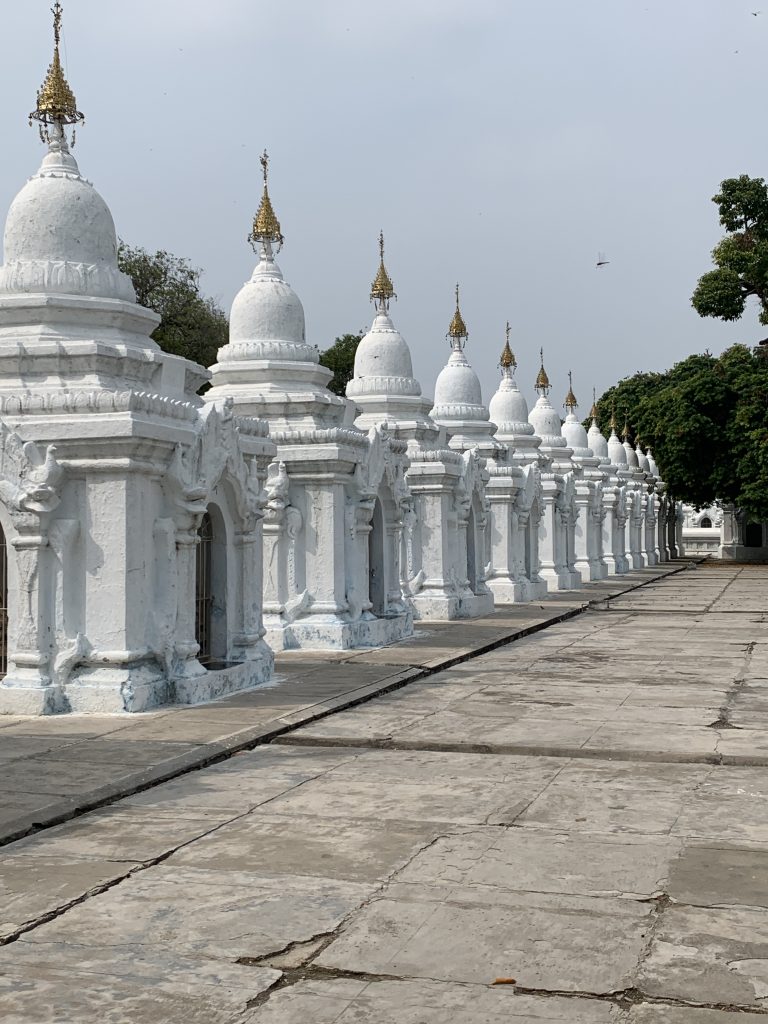
Kuthodaw Pagoda 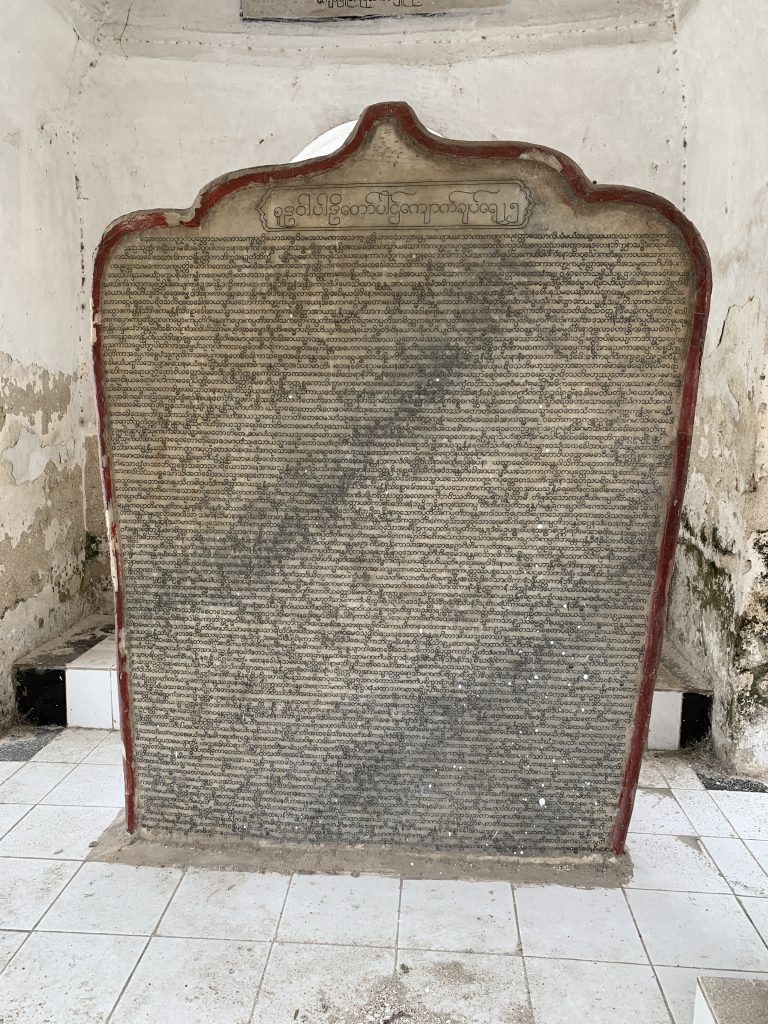
Tripiṭaka tablet 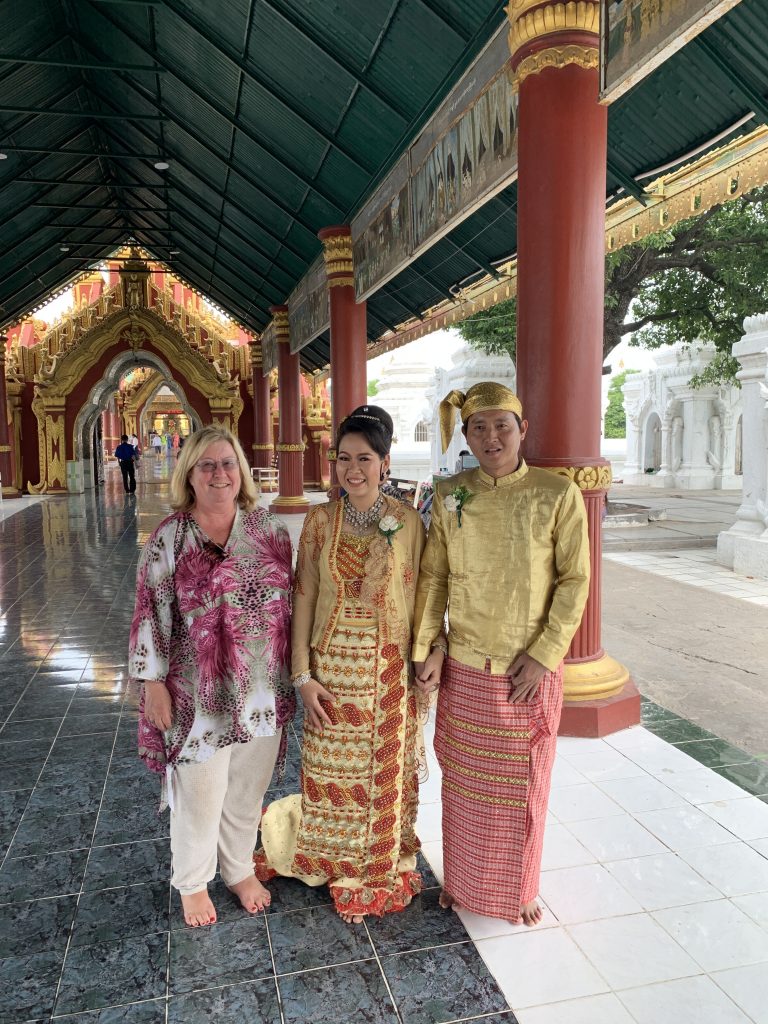
The Golden Palace Monastery is very close to here and worth a look. It is being restored by the American Embassy. The palace was originally a retreat for the king, and with a family of over 100 children, I am not surprised he needed some peace and quiet. The palace is made of teak, wonderful carvings and when fully gilded must have looked stunning. The gold has now worn off mostly, how much will be put back on will be interesting to see, and once completed there is talk that one won’t be able to visit inside, which seems somewhat daft.

Golden Palace 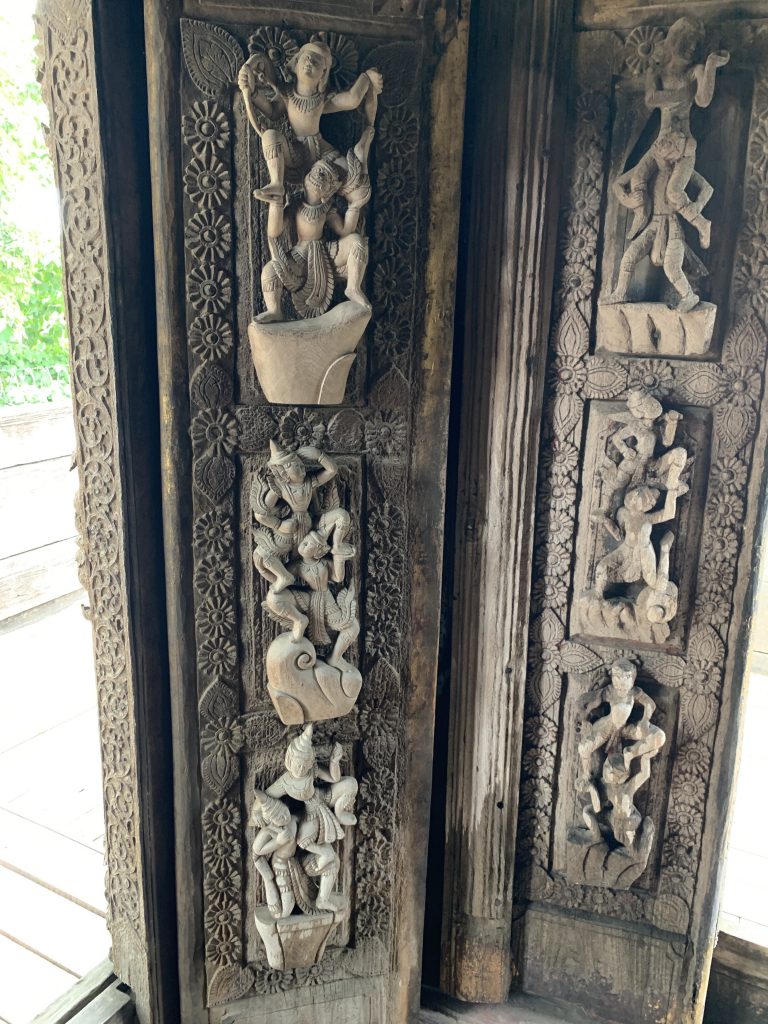
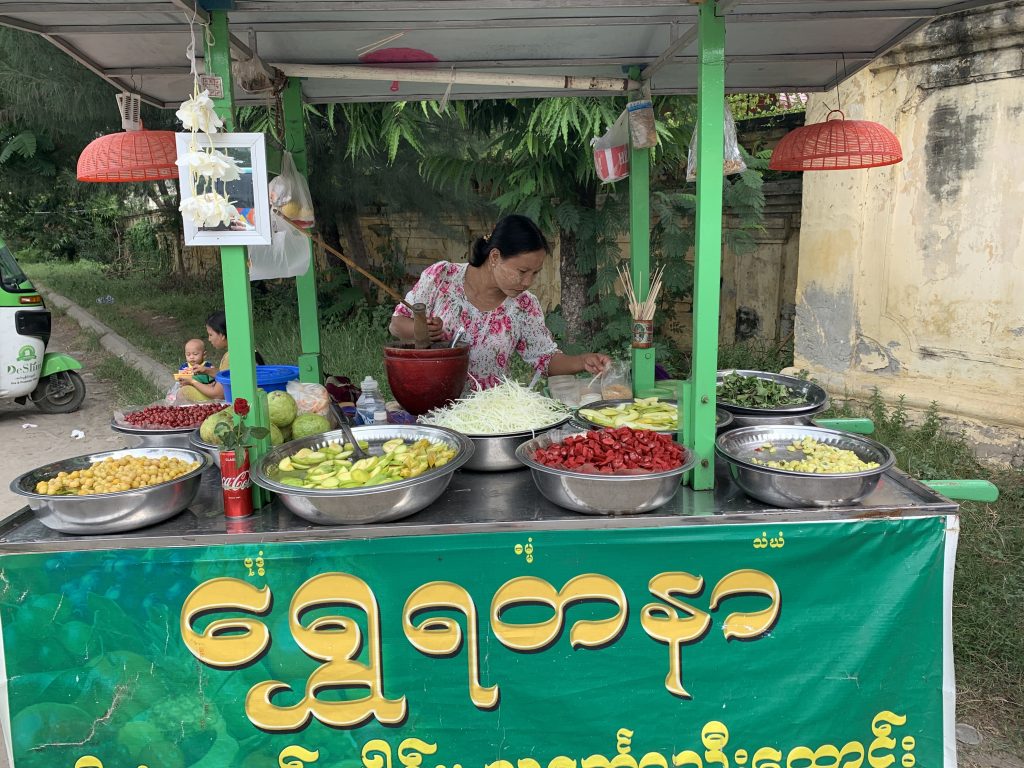
Street food and lady with thanaka on her face
Oman Muscat
Saturday evening sunny and dry heat zero humidity, and the Millennium Hotel is dry too! Not even a tonic water to go with my gin, I task them with getting some by the following day.
Oman is a small country a population of 5.6 M and Muscat the capital has1.56M, 17 dialects are spoken. The safest place for women to live in the world evidently after Luxembourg.
The Sultan is revered as there is now free education, free medical care and 85% of Doctors are Omani evidently. Equals rights for men and women, there are 5 women who are heads of ministries, women can drive, be in the police and the army, and have equal land rights. At 23 you can apply for some free land and you will eventually get 600 sq. metres on which to build yourself a house. Land that is yours to sell at any time. And there are no taxes. I surmise the Sultan is gay as he hasn’t married, has no heirs and has never been seen with a woman in public. Our guide skirts round the whole thing.
The national dress for men is the dishdasha which can be any colour but pink. Formal wear is white. I ask him what he is wearing underneath as everyone wants to know, just like they were interested in what went on under the Burmese guys longyis. A thin cotton petticoat is worn under the long white robe and a vest on top. No pants and no socks. He says young boys often wear belts to avoid accidents but adults manage without. The dishdasha also has a tassel round the neck and this is so perfume can be added so they all smell nice. Abdul then tells us about Oud a local perfume and Amuaje. Amuaje is made from jasmine, frankincense sandalwood and spices. He says we can buy some for between 200/250 US at the museum. Or 100 US at the airport.
The Sultan Qaboos Mosque our first port of call in what is a whistle stop tour, is one of the largest in the world and no expense has been spared, the main chandelier made in Turkey, once the largest in the world now superseded by one in Abu Dhabi, weighs over 8 tons and has more Swarovski crystal imaginable. The teak comes from Burma. The women’s mosque can accommodate 750 and in total with the outside area all nicely marked out in marble, can accommodate 20,000 worshipers. The men’s Mosque is infinitely more spectacular and larger than the women’s prayer area. Has a one-piece carpet made evidently in situ and I can’t work out quite how you do that. Pictures don’t really do it justice.

Grand Mosque 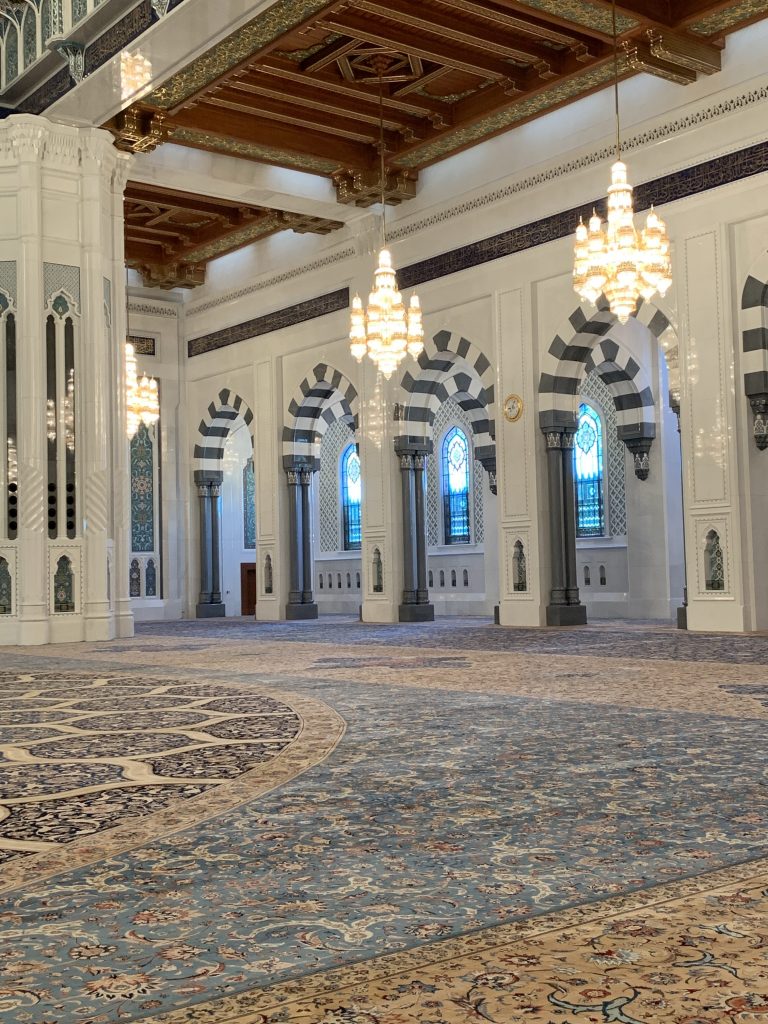
Acres of seamless carpet 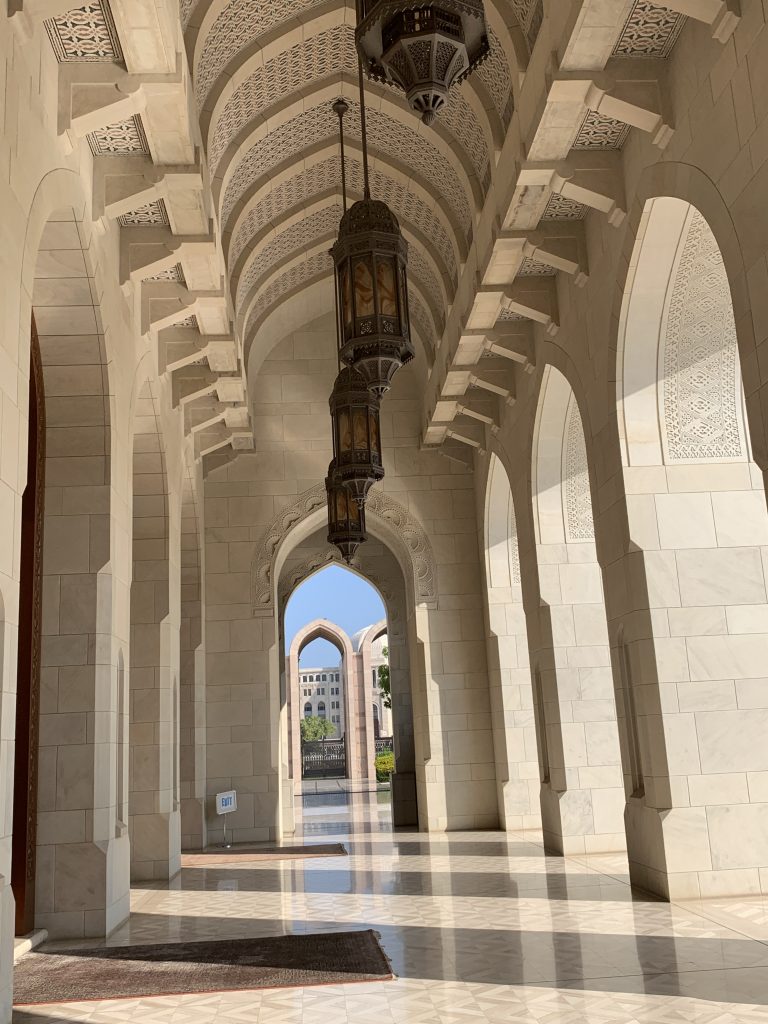
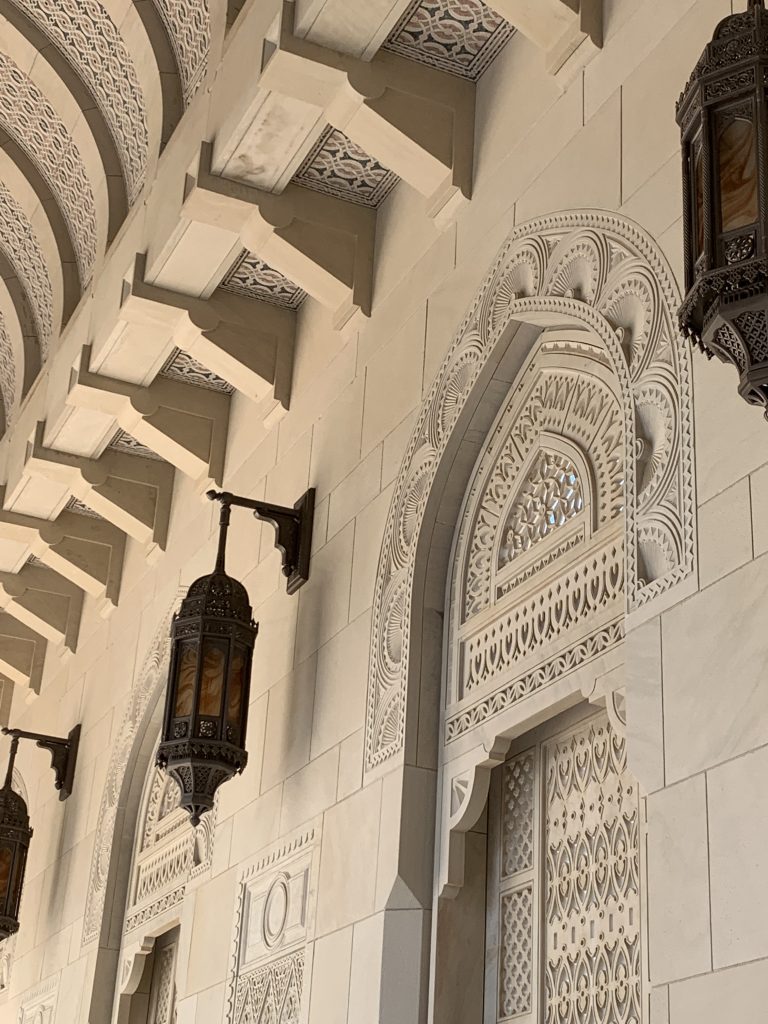

Muttrah Souk
Next stop the souk where frankincense burns together with other local smelly delicacies. I buy everything required an incense burner the small charcoal bricks the frankincense and some Amuaje. It smells lovely and I get a small bottle for 20 bucks and think happy days. One of our party later does spend the 200 or so bucks on a very nice colourful box and cellophane that would do Harrods proud. Saffron is also cheap here, there is wonderful metalwork and marquetry, with intricate backgammon sets and lovely boxes. I’m spent up and have enough junk.
The Bait al Zubair cultural centre / museum is worth a visit, more a taste of life in Oman, the different areas the clothes, jewellery customs, and what happens at weddings. Still the groom is responsible for all costs and transport costs of guests as well. And 500 seems to be about the minimum number you have to cater for. Last stop the Al Alam palace used for visiting dignitaries rather than as a home. The love affair with Britain is clear from the metalwork, railings and street lamps. Supplied by the UK clearly, the gold shields being 100% gold and I can’t see them lasting long in London, but then this is the Gulf and Sharia law is still in force.
The trip finishes off on the Gulf of Oman with a sunset cruise on a dhow.
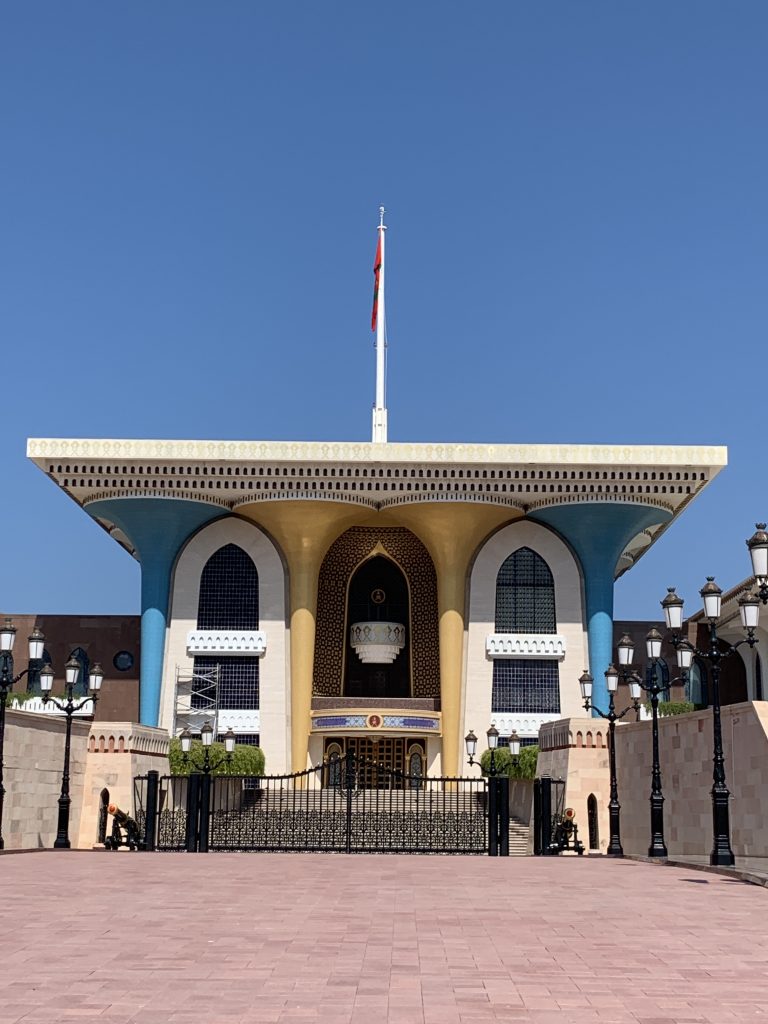
Al Alam Palace, complete with British street furniture. 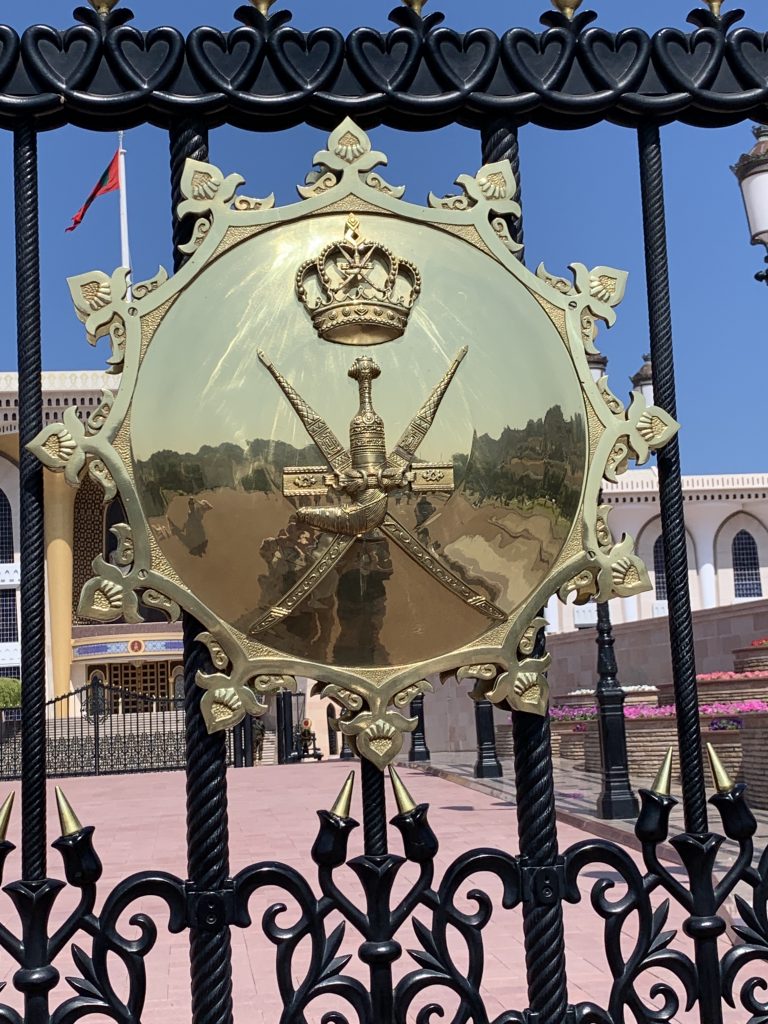
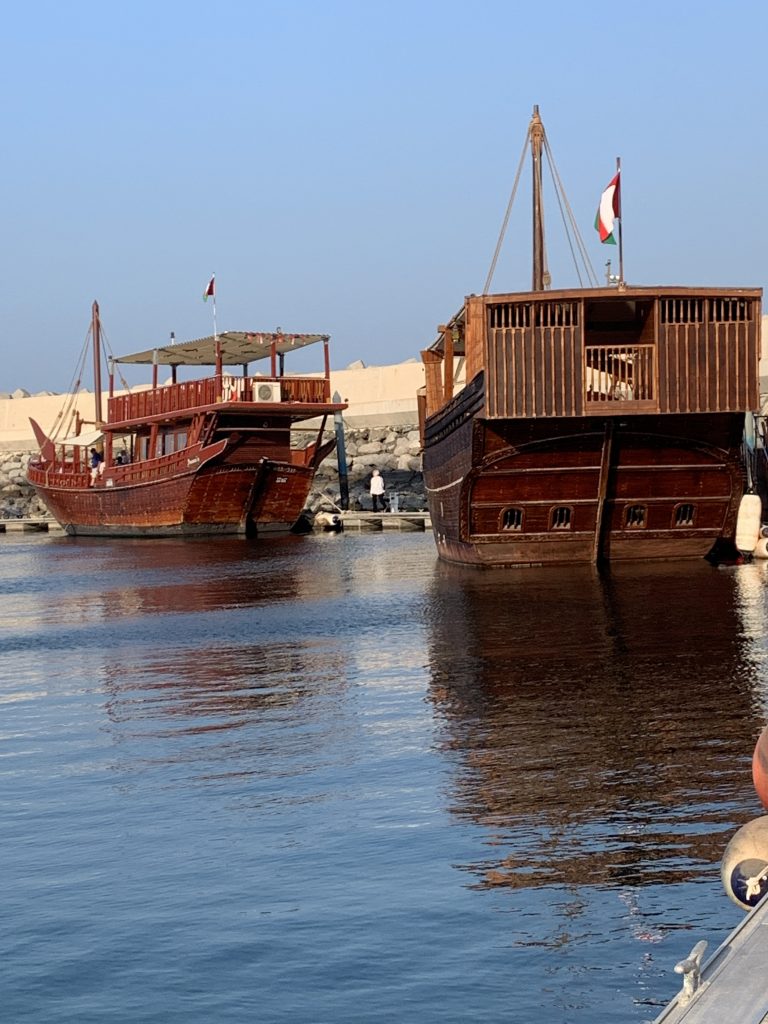
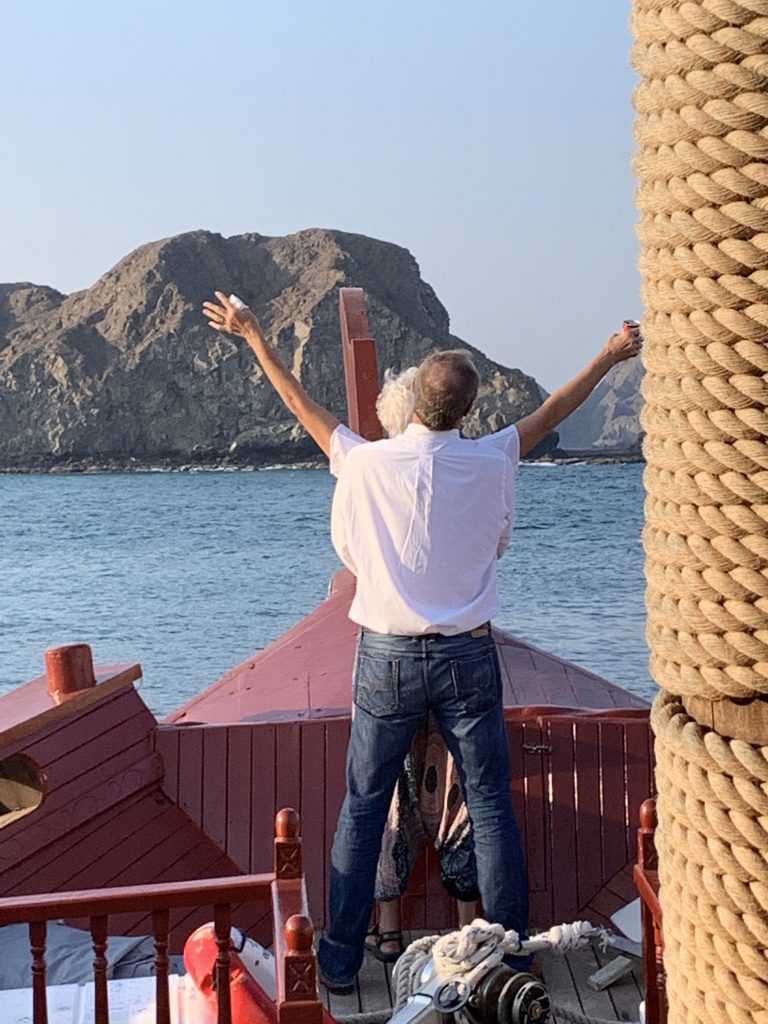
Titanic Moment 